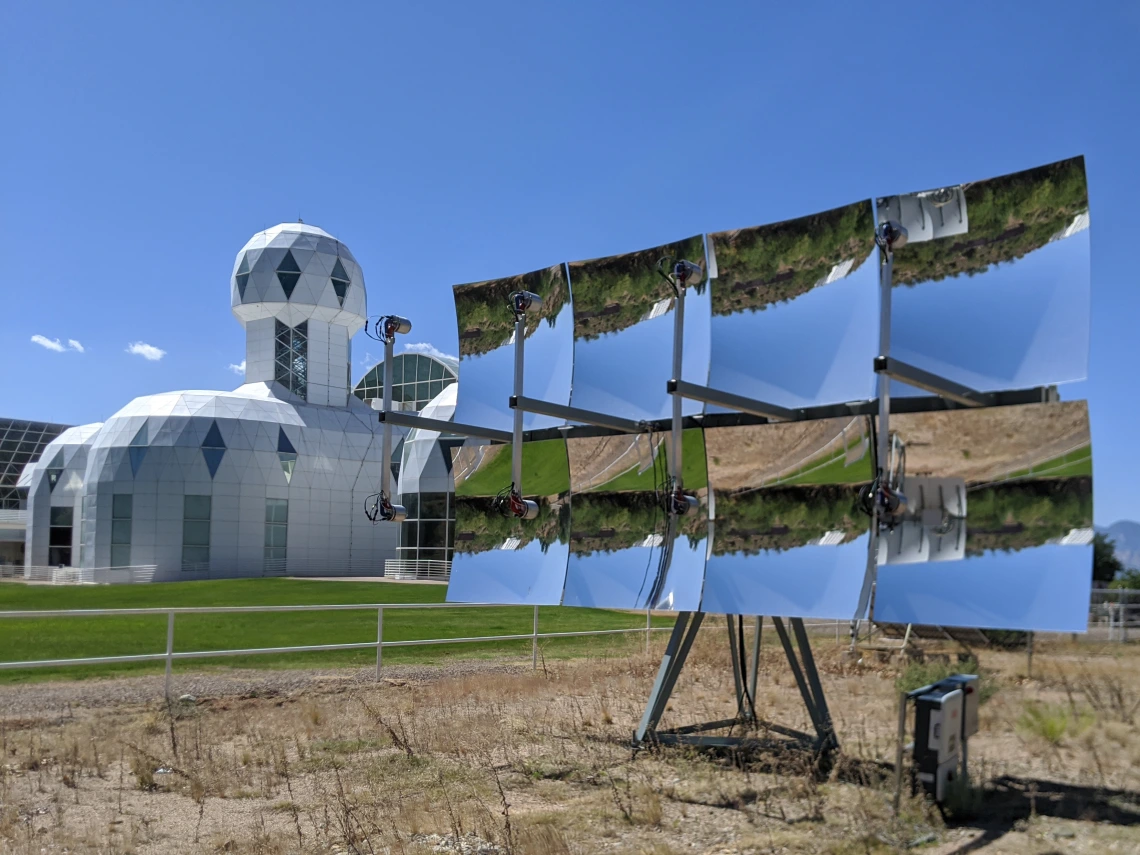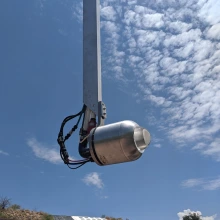Startup Licenses Alternative Solar Energy System
The high-efficiency photovoltaic system licensed by Gen3 captures more heat and energy than currently available solar panels.

The test system implementation at the UArizona Biosphere2.
David Vili
Update, 5/12/22: Gen3 is now SolarSpace. Learn more at https://solarspace.io/.
TUCSON, Ariz. — Over the course of recent years, University of Arizona researchers from the College of Science and the James C. Wyant College of Optical Sciences have been developing and refining a highly efficient photovoltaic system that captures more heat and energy from sunlight than current solar panel models available.

The system's mirrors collect and focus light to a small point.
David Vili
Most of today’s photovoltaic systems use flat solar panels, which while functional, are relatively inefficient in their ability to capture and convert the sun’s energy. The UArizona technology, originally invented by Regents Professor of Astronomy and Optical Sciences Roger Angel, utilizes large mirrors which focus sunlight onto small, multi-junction solar cells, converting the light into energy through a high-efficiency process, similar to how a magnifying glass focuses sunlight to one small point.
Now, the technology has been licensed to startup Gen3, with the goal of manufacturing photovoltaic generator modules for commercial and industrial use.
The company’s founder David Vili, born in the country of Georgia in Eastern Europe, came to the United States in 1992 to pursue a business degree. While on a pilgrimage at a monastery in Arizona, he visited a UArizona showcase at the College of Science Biosphere 2 and came across the invention. He met the researchers behind the project and eventually purchased a photovoltaic unit for the monastery, providing it with an independent electricity system.
“I went to buy this [technology] for the monastery, so they would have an independent solar energy system,” Vili said. “[The monastery has] 50 monks who live in a desert. They're brilliant, brilliant people who devoted their lives to worship and have said no to every earthly pleasure that we get. So all of us who go there, we try to help as much as we can.”
Vili recognized the potential for commercialization and his contribution to the monastery marked the beginning of Gen3.
Currently, Gen3 is perfecting the design and making sure that the technology works in a variety of environments and weather conditions. The company is also developing maintenance mechanisms and user protocols.
“We’re using the monastery as a testing ground,” Vili said. “We’re making the system simple to use and making sure that it’s durable — it's one thing to control for wind and dust particles in the electronics; controlling for a monsoon is another thing entirely.”

A special lens serves as the focal point for collected energy.
David Vili
He continued, “We’re spending about 80 percent of our time over the next six months making sure the bolts are tight on this technology and the system works. For the other 20 percent, what my team and I want to do is innovate. I don’t think staying with what you have is ever enough. I think it’s important to try to take the next step. Right now we are working on one prototype and I'm sure there will be more.”
The company is currently partnering with different researchers and universities to combine technologies and develop potential applications for the system, from generating clean alternative energy to making potable water more widely available.
“There are researchers who are using solar generators to split water into hydrogen, so one potential use of our technology, not just making electricity directly, but also making hydrogen,” Vili said. “Hydrogen is an absolutely clean energy that we can use instead of fossil fuels. Other researchers we’re working very closely with are taking CO2 emissions and turning them into fuel again.”
Partnering with Tech Launch Arizona, the UArizona commercialization arm, Vili has been able to confidently work on Gen3 and says he cannot put a value on his experience with TLA.
“We’re excited that Gen3 is taking this technology forward,” said Rakhi Gibbons, TLA Director of Licensing. “More than ever, we need alternative energy solutions, and this invention provides an excellent option for the solar industry.”
Vili said, “The reason I jumped right into [Gen3] was because of TLA. I knew that with TLA I had support and a strong backing. I’m lucky to work so closely with the team, and I love seeing all of the energies that are present. Everyone is passionate and brings unique expertise — you can’t ask for anything better than that.”
In this first phase, the company is running a pilot implementation of their technology at the monastery with 15 units. Next, they want to build up a larger factory and move into a full installation at the monastery with an estimated 160 units, giving Gen3 a full-scale case study.
For their third phase in the next three to five years, Gen3 plans to work with governmental and private clients on a large-scale to implement solar projects throughout the United States and eventually overseas.
“I think this technology has a very big potential,” Vili said. “Look at what we’re doing to the earth, with all of the climate change. The energy is there. So let’s use it.”

